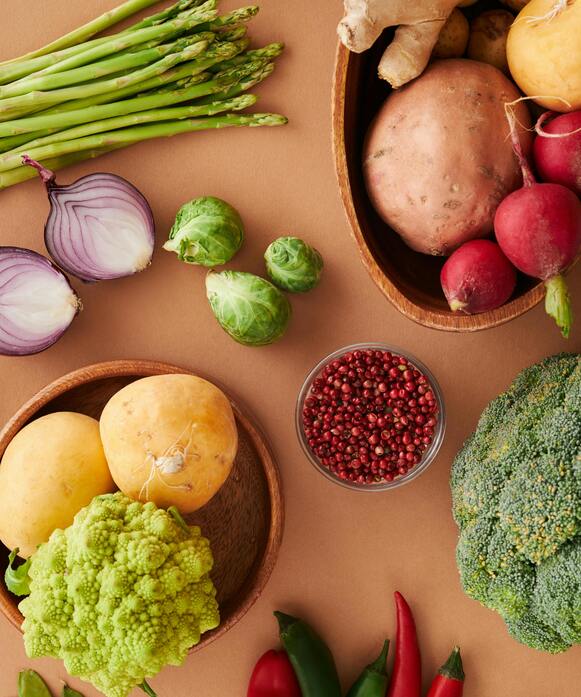Trapped Wind
Date:
16 Jan 2022

For the most part, gas production in the gut is a perfectly normal occurrence and has been reported as the most common digestive complaint.1
Our bodies produce gas when breaking down and digesting food; a little post-meal bloating can be expected.
When trapped wind and bloating become particularly prevalent or the symptoms experienced become pervasive, we seek to find relief.
What is Trapped Wind?
Trapped wind can be described as an uncomfortable or, less commonly, painful feeling of pressure from within the abdomen, which causes the stomach to distend and may accompany abdominal cramping.2
Trapped wind is a build-up of gas and air in the digestive tract, which may accumulate rather than move progressively through the tract and out through the colon.
Symptoms of Trapped Wind
Physical Symptoms
Symptoms can vary from:
- Notable distention of the stomach
- Increased flatulence
- An uncomfortable sensation around your ribs
Stomach gurgling
- Feeling uncomfortably full after eating
- Stomach cramps
- Clothes feeling tight
- Nausea
These physical symptoms can range from mild intermittent discomfort to (less commonly) debilitating, reducing the ability to function in daily life.
Irritability
From the symptoms shown above, it’s no wonder that irritability and general low mood can be experienced.
Our brain and gut have shown to be intrinsically linked through the gut-brain axis, a series of interconnected communication pathways between our gut and brain. If the gut function is impaired, it seems likely that this will impact general mood.3
What Causes Trapped Wind?
Chewing gum
It is common to take in air whilst eating and drinking; however, chewing on chewing gum causes us to swallow more air than usual which then builds up in the digestive tract and may cause related symptoms.
Fizzy drinks
Artificial sweeteners in fizzy drinks may be problematic for the stomach to break down, causing excess gas to build up within the digestive tract.
A High Fiber Diet
Human enzymes do not break down high fibre foods and those exceptionally high in soluble fibre once they reach the stomach; therefore enter the intestines as food for bacteria and organisms living there.4
Fermentation occurs from this process as the live organisms feed on the fibre, which produces gas and metabolites.5
Constipation
Slow gut motility can cause foods to sit in the digestive tract and putrefy. Decaying food releases excess gas and waste products from the toxins released and can be a major cause of stomach distention and gas.6
Lifestyle factors
Our lifestyle can have a significant effect on our digestive health. Alcohol, especially fermentable drinks such as beer, can directly add excess gas to the gut, whilst cigarette smoking causes more air to be sucked in through inhaling.
Stress can also impact how much air we take in due to an increase in short rapid shallow breathing when we are in a state of panic or overwhelm.7
Digestive Disorders
Inflammatory bowel disease and IBS have both been shown to link to abdominal hypersensitivity, which means if the gut lining is irritated or inflamed, this may cause the stomach to bloat.8
An overgrowth of bad bacteria in the intestines, named Small Intestinal Bacterial Overgrowth (SIBO), can contribute to bloating and trapped wind.
It is thought that low gut motility, leading to over fermentation of food in the digestive tract, can cause symptoms.9
How to Relieve Trapped Wind
Read on for a few tips on what to do to help relieve trapped wind.
Avoid Trigger Foods
It may be helpful to keep a food journal and track which foods cause bloating and trapped wind. Reducing or removing food triggers may reduce symptoms and bring relief.
Lactose and gluten are the most common food triggers studied for their link to gastrointestinal symptoms,10 therefore, it may be important to record how these foods make you feel.
Gradually Increase Fibre Intake
As mentioned, foods particularly high in indigestible fibre can cause excess gas and trapped wind.
High fibre foods are essential to our dietary intake due to their role in satiety and keeping the gut (particularly the colon) healthy.11 It is important to slowly increase fibre intake for the gut microbiome to adapt to the dietary change.
Once the ecology of the microbiome within the gut adjusts to accommodate the increase in fibre intake, gas production will decrease to normal levels.
Peppermint Oil
Peppermint oil has been shown to reduce excess gas and abdominal distention by soothing the gut lining and helping food to move through the gut effectively. Consider drinking peppermint oil tea and track whether symptoms improve after two weeks of daily intake.12
If, however, you experience acid reflux, it may be best to avoid peppermint as it may aggravate symptoms.13
Increase Gut Motility
As mentioned, constipation and low gut motility can significantly contribute to excess gas and trapped wind.
Introducing foods with prokinetic properties is a natural and functional medicine approach to helping foods move through the digestive tract.14
Increase intake of:
- Ginger
- Bitter foods – dandelion, rocket, broccoli
- Globe Artichoke
- Garlic
If the above tips bring no relief or your symptoms are particularly pervasive and impact daily life, you may be advised to contact your GP.
References
2. Bloating and Abdominal Distension: Old Misconceptions and Current Knowledge - PubMed (nih.gov)
3. Gut Microbiota-brain Axis - PubMed (nih.gov)
4. Effects of Probiotics, Prebiotics, and Synbiotics on Human Health - PubMed (nih.gov)
5. Colonic health: fermentation and short chain fatty acids - PubMed (nih.gov)
6. Management of Chronic Abdominal Distension and Bloating - PubMed (nih.gov)
7. Physiology of the Autonomic Nervous System (nih.gov)
8. Gastrointestinal Physiology and Function - PubMed (nih.gov)
9. Small Intestinal Bacterial Overgrowth: Clinical Features and Therapeutic Management (nih.gov)
















